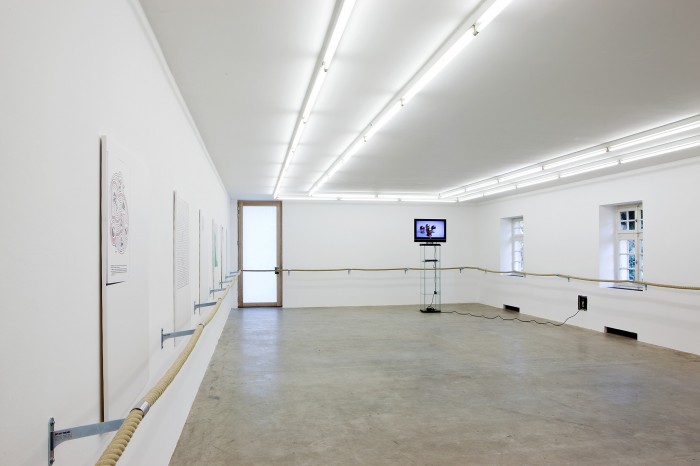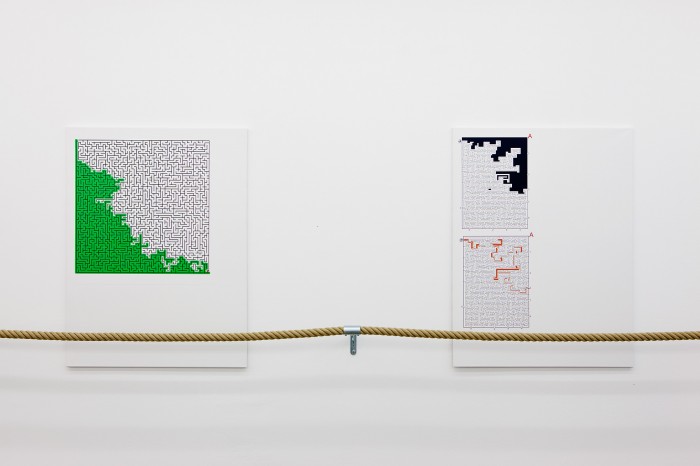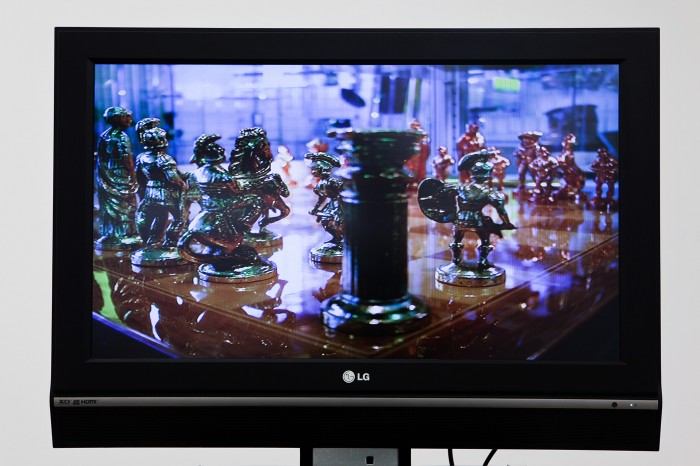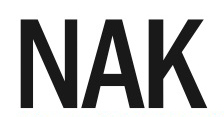Cruise Line
SIMON DENNY
OPENING:
Saturday 19 March 2011
8 PM
OPEN:
20 March
—
1 May 2011
“He is a man who is good at going to sleep. It is his peculiar talent. Until that day he can do it professionally, he fancies himself a proletarian, and certainly if laze is a labor, he is by now at least a foreman.” (Mark von Schlegell)
Simon Denny’s art is situated between spatial exploration and a careful examination of display. In his often fragile and seemingly haphazard installations employing a wide variety of materials, the distinctions between “real” and “virtual” spaces collapse on the surface of such interfaces. Denny takes on popular entertainment and consumer cultures and their technical mediums of dissemination, fashioning out of old television sets aquarium-like and trashy-rickety sculptures, which, in the era of the flatscreen, quote in an ironic-melancholic way the former status object of the television set as an item of furniture and living room altar. He also arranges within a given space the various sets according to their depth in order to make evident, in the manner of an evolutionary history, the “flattening” transformation of the bulky object in the room into the “image on the wall.”
CRUISE LINE, Denny’s exhibition at NAK. Neuer Aachener Kunstverein, moves away from the theme of “television”, however, borrowing its title from the ██████ ███████ fleet of cruise ships, the ██████ Cruise Line. The four ships in their fleet are full-spectrum theme parks for the entire family—comic worlds made real: with █████ Character Greetings in the morning, splashing around the ██████ ██████ swimming pool in the afternoon for the kids, and the ██████ Menu and ██████ Revue for adults in the evening. And all of this while back in the cabins, towels folded like cute puppies on the beds. In short: these ships are floating entertainment fortresses, themed and self-sufficient corporate worlds operating at sea—spheres in which to move around while they themselves are in motion.
Denny’s CRUISE LINE also views itself as a kind of “scripted environment” without an exterior, as a physically accessible image and game fashioned from a wide variety of materials and mediums with sealed, airtight surfaces and constructed realities all the way down to the so-called “scene behind the scenes.” In a total of three works Denny focuses on Aachen-based ████ ████, a company responsible for the metallic surface finishing on the ██████ ██████, the newest ship in ██████ fleet. On view on a flatscreen monitor downstairs is a 3D tour of the company’s facility, directly alongside of which Denny presents odd-amorphous byproducts of the chroming process beside one of his television set sculptures. This pairing is taken further on the main level with a documentation of the final polishing of the chrome, like the parts on the ██████ ██████, produced with the ██████ ██████ crew. Whereas, in the case of the facility tour, 3D technology makes stepping into the images seem possible, and the television cabinet itself becomes a motionless image, here the images simply meld together on the surface like a screen saver. Viewed as a whole, these works operate as a kind of three-phase elucidation of the various relationships between image and space, which mostly only ever produces one thing: new opaque surfaces.
Lastly Denny has transformed the main gallery into the simulation of a ship’s deck by running a railing-style rope around the perimeter of the space. This rope not only cuts across the window of the Kunstverein but seven digital prints as well—labyrinths of varying complexity that are led to absurdity with the use of a simple trick: if opening them in an image editing program and clicking on them with the selection tool, they fall apart into separate halves and the pathway out is revealed. What appears complicated and opaque at first is made transparent and obvious, reduced to pattern and decoration. CRUISE LINE relentlessly plays this game of excavation and revelation; shells, sheathing, and surfaces crop up everywhere. Here everything is reduced to a single level—even including the exhibition publication produced by Denny and NAK in conjunction with the writer Marc von Schlegell and cultural critic Norman M. Klein: it is also integrated into the exhibition on the same level of the show’s others components, in this case as a .pdf projection. That such things would be “more banal” and easier to grasp through all the literal and metaphorical flattening is a fallacy. Exactly the opposite is the case.
Simon Denny (*1982 in Auckland, New Zealand) studied at Elam School of Fine Arts Auckland, New Zealand, and at Städelschule, Frankfurt am Main, with Prof. Willem De Rooij. Denny lives in Berlin.
The accompanying publication is financed and published together with Daniel Buchholz gallery. It will be published with Buchhandlung Walther König in Cologne.



